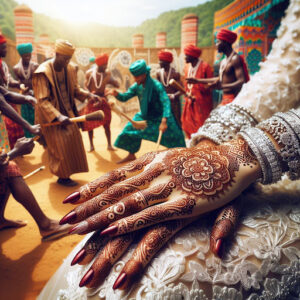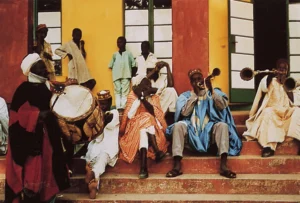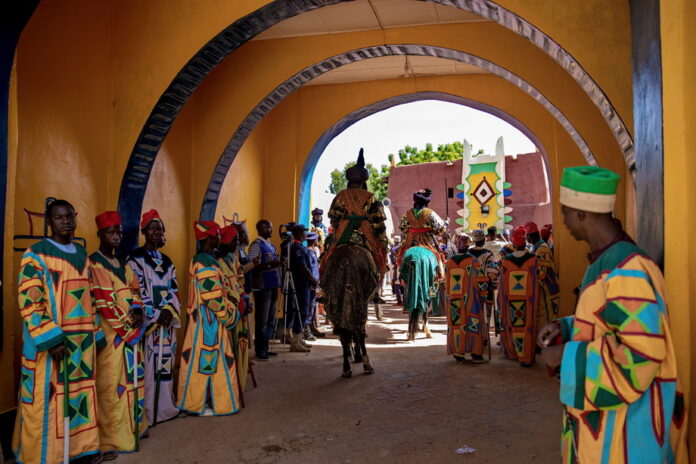

The Hausa people are the largest ethnic group in Nigeria, comprising approximately 30% of the country’s population, which is expected to exceed 230 million by 2025. They live in the northwestern part of Nigeria and southern Niger. This region, known as Hausaland, covers approximately 75,000 square miles. The Hausa language belongs to the Afro-Asiatic family and has over 25 million native speakers.
It is also widely spoken across West Africa as a common language. Most Hausa people are Muslim. However, some still follow traditional beliefs. In the past, the Hausa built strong city-states and were key players in trans-Saharan trade. Cities like Kano and Sokoto grew into major centers of culture and business. The Hausa are a powerful force in Nigerian politics, business, and daily life. Their influence is felt both locally and across West Africa.
History of the Hausa People
The Hausa people’s origin begins with Bayajidda, said to be an Arab prince from Baghdad. Around the 9th or 10th century, he journeyed across the Sahara to Daura, in present-day northern Nigeria, where he killed a great serpent that had blocked the town’s well. The queen of Daura, Magajiya Daurama, rewarded him with marriage. She already had six sons. With Bayajidda, she bore a seventh, Bawo. These seven sons later became rulers of seven Hausa city-states: Biram, Daura, Gobir, Katsina, Kano, Rano, and Zaria. They all formed the Hausa Bakwai, the core of the Hausa world. While historians question the tale, many agree that the Hausa people likely came from a mix of native Sahelian groups, Berber migrants, and possibly East Africans.
The Hausa city-states began to form between 500 and 700 AD. They were independent, but connected by culture, trade, and language. Biram was the first capital. Gobir acted as the military shield of the region. Kano and Rano became textile giants, famous for their indigo-dyed cloth. Zaria exported grain and slaves. Katsina and Daura linked the region to North Africa through the trans-Saharan trade, dealing in salt and goods from far-off lands. Arab writers in the 9th century noted the rise of these Hausa cities. Yet, despite shared roots, the city-states never united under one rule. Rivalries and wars between them were common. By the 13th century, the Hausa states had grown rich. They competed with powerful neighbors like Kanem-Bornu and the Mali Empire. They traded in leather, gold, cloth, salt, kola nuts, and more. Hausa artisans gained fame for their work in metal, glass, and leather.
Each state had its own army and royal court. Farming depended on free labor, and large palace buildings became common. Islam came to Hausaland through trade. By the 11th century, Muslim merchants and pilgrims brought the religion south. Some rulers converted for status. Most people kept older beliefs. In the late 1400s, the scholar Muhammad al-Maghili spread Islam further. By the 1500s, the Hausa began using a modified Arabic script, Ajami, to write their language.
The Kano Chronicle, a key historical source, was written in this script. Still, the city-states were divided. In the early 1800s, Usman dan Fodio, a Fulani scholar, launched a jihad. It lasted from 1804 to 1808. His goal was to reform Islam and end Hausa rule. He succeeded. The Fulani overthrew the Hausa kings and joined the city-states under the Sokoto Caliphate. Then the British arrived in the early 1900s. They took over but ruled indirectly. Hausa leaders were kept in power, now under colonial control, which preserved Hausa traditions, identity, and influence.
Language of Hausa People
The Hausa language, spoken mainly in Nigeria and Niger, is one of the most widely used and richest languages in Africa. With over 41 million speakers, about 26.9 million native and 15 million second-language users. Hausa belongs to the Chadic branch of the Afro-Asiatic language family. This makes it quite different from most Nigerian languages, which are part of the Niger-Congo group. It’s a lingua franca across northern Nigeria, southern Niger, Benin, Chad, Cameroon, and parts of Côte d’Ivoire and Burkina Faso.
Grammar and Structure
Hausa has a clear gender and number system: masculine, feminine, and plural forms. Nouns and adjectives often end in long vowels. Verb forms are grouped into stem classes, each with patterns of vowels and tones. A key feature is Final Vowel Shortening (FVS), a process that affects meaning and marks tense or mood. Hausa also uses Tense-Aspect-Mood (TAM) markers between the subject and the verb to show time or attitude. Palatalization affects how consonants sound before front vowels and plays a role in forming plurals or compounds.
Writing Systems
Hausa is written in two scripts:
- The Latin alphabet which is used in schools, media, and government.
- The Ajami script, based on Arabic, is used in religion and traditional texts.
Vocabulary and Meaning
Hausa borrows many words from Arabic, due to its long history with Islam and trade. The language also uses ideophones, words that imitate sounds, actions, or feelings. Instead of adding endings to verbs to show causation, Hausa uses whole verbs like sâa (“to cause”).
Religion of the Hausa People
The Hausa people are predominantly Muslim. Islam has influenced their lives for centuries, since around the 11th century. It came through trans-Saharan trade routes and Islamic preachers from North Africa, Mali, Guinea, and Borno. Presently, about 95% of Hausa people are Muslims. They follow the teachings of the Prophet Muhammad, pray five times a day, fast during Ramadan, and gather in mosques for worship. Islamic festivals like Eid al-Fitr and Eid al-Adha are major celebrations. Islam also influences their culture, law, and leadership. Since the Sokoto Caliphate was established in the early 1800s, Islamic principles became even more central in Hausa politics and daily life.
Traditional rulers like emirs serve as both community and religious leaders. The Hausa language has many Arabic words, and some people can read Arabic. This is common in religious schooling and Quranic studies. Still, not all Hausa practice Islam. A small group known as the Maguzawa, mostly in rural areas, continues to follow traditional beliefs. There is also a small Christian minority, about 5%, mostly found in cities. Christianity among the Hausa is a recent development compared to Islam.
Culture and Traditions of The Hausa People
Hausa society is traditionally ruled through a system of emirates. Each city-state has an emir, a leader with both political and religious power. This system dates back to the days of the Sokoto Caliphate. Under the emir are titled nobles called Masu Sarauta. They handle government duties like tax collection, military affairs, and justice.
Society follows a feudal structure, where village heads report to chiefs, who report to the emir. Family life is based on the male line (patrilineal). Large extended families live together in compounds called gidaje. Polygamy is common, allowing men to marry more than one wife to form family alliances and grow their households. Many areas use Sharia law, and religious events like mosque prayers, Eid celebrations, and market days are key to social life.
Arts and Crafts
The Hausa are skilled artisans. Kano is famous for its leather goods, sandals, bags, and saddles. Indigo-dyed cloth from the region is prized for its blue color and fine designs. Blacksmiths make tools, weapons, and jewelry with cultural meaning. Other popular crafts are pottery, woodwork, and perfume making. These traditions are passed down through families and boost local trade across West Africa.
Music and Festivals
Music and dance are central to Hausa life. They are used in royal events, worship, and celebrations. The kakaki, a long metal trumpet, is used in royal parades. The kalangu or talking drum can imitate human speech and is used in praise songs. Festivals align with Islamic events like Eid al-Fitr and Eid al-Adha. Agricultural festivals are always the beginning or end of farming seasons.
Traditional Clothing
Hausa clothing is modest and elegant. Men wear Babban Riga, a flowing robe over a kaftan, with a cap or turban. Women wear wrappers and long gowns, with headscarves or hijabs. Jewelry, such as earrings and beads, is common. Henna is used to decorate hands and feet during celebrations.
Cuisine
Hausa food is simple but full of flavor. It includes grains like millet, sorghum, and rice.
Popular dishes:
- Tuwo: Thick porridge served with soup
- Suya: Grilled spicy meat skewers
- Kilishi: Dry spiced meat, like jerky
- Fura da Nono: Millet mixed with fermented milk
- Kosai: Fried bean cakes
Marriage and Family
Marriage is guided by Islam and culture. Physical contact before marriage is discouraged. Families arrange most matches to ensure respect and compatibility. The wedding includes the Nikah (Islamic contract), a Mahr (bride price), and modest celebrations. Polygamy is accepted. Women manage homes but also trade or create crafts, especially in cities, where they gain more influence and independence.
Economic Life of Hausa People
The Hausa people make up around 30% of Nigeria’s population and are a powerful force in the country’s economy. Their way of life is tied to farming, trade, and crafts. Most Hausa people farm for a living. They grow millet, sorghum, maize, rice, and groundnuts. Many also raise animals like cattle, goats, and sheep. Some farms are small and feed only families, but others grow crops like groundnuts and cotton for sale. Kano, Katsina, and Zaria have been trade cities for centuries. Markets like Kurmi in Kano still draw buyers and sellers from all over West Africa.
Hausa traders are well known for transporting goods across borders, including grains, leather, textiles, and more. They’re also renowned for their craftsmanship. In cities like Kano, artisans produce leather goods, woven fabrics, pottery, and metal tools, many of which are exported. However, small-scale producers face significant challenges: outdated tools, limited funding, and weak connections to international markets. Nigeria’s economy is expanding, with the World Bank projecting 3.6% growth in 2025. But inflation remains high, 22.97% as of June 2025. Poverty is still rampant, particularly in the north. Around 106 million Nigerians live on less than $2.15 per day, and many of them are Hausa.

